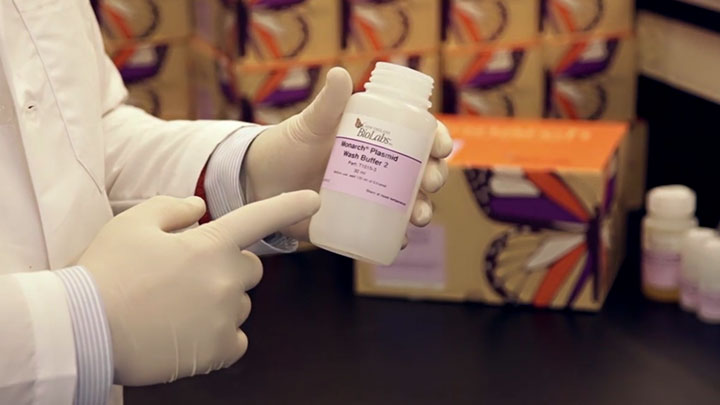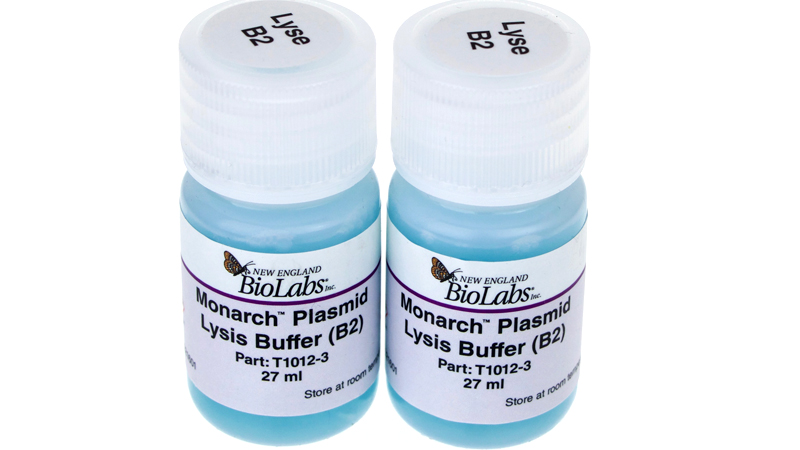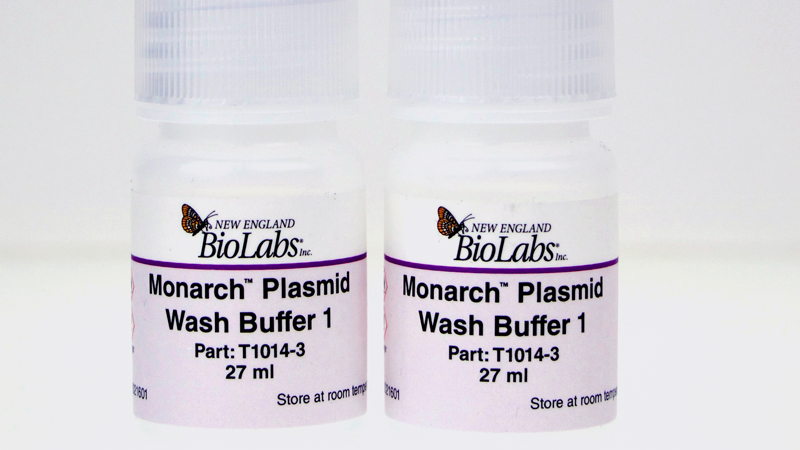Monarch® Plasmid Miniprep Kit
Product information| Code | Name | Size | Quantity | Price | |
|---|---|---|---|---|---|
T1010G_SAMPLE |
Monarch Plasmid Miniprep Kit, Sample |
10 preps | - | Unavailable in your region |
Monarch® Plasmid Miniprep Kit
- Replaced by Monarch® Spin Plasmid Miniprep Kit on December 06, 2024
- Catalog # T1010 was discontinued on November 08, 2024
Product Introduction
The Monarch Plasmid Miniprep Kit is a rapid and reliable method for the purification of up to 20 μg of high quality plasmid DNA.
- Elute in as little as 30 μl
- Prevent buffer retention and salt carry-over with optimized column design
- Reduce hands on time with faster protocols and less spin time
- Monitor completion of certain steps using colored buffer system
- No need to add RNase before starting
- Easily label columns using tab and frosted surfaces
- Buffers and columns available separately
- Significantly less plastic used when compared with other kits
- Responsibly-sourced and recyclable packaging
- No hazardous materials fees

Check out our Technical Note containing comprehensive insights into measuring and analyzing nucleic acids.
| Catalog # | Size | Concentration |
|---|
Featured Videos
View Video Library-

Tips for using the Monarch® Plasmid Miniprep Kit
-

Monarch® Plasmid Miniprep Kit protocol
-

How to recycle your Monarch® Kit components
-

NEB® TV Ep. 6 – Sustainability
-

Quick Tips - How can I avoid genomic DNA or RNA contamination in my minipreps?
-

Quick Tips - How can I maximize yield when using the Monarch® Miniprep Kits?
-

Quick Tips - How do I apply my elution buffer to the Monarch® nucleic acid purification column?
-

Quick Tips - What protocol adjustments can I make when purifying a large plasmid?
- Product Information
- Protocols, Manuals & Usage
- FAQs & Troubleshooting
- Citations & Technical Literature
- Quality, Safety & Legal
- Other Products You May Be Interested In
Product Information
Description
The Monarch Plasmid Miniprep Kit is a rapid and reliable method for the purification of high quality plasmid DNA. This method employs standard cell resuspension, alkaline lysis, and neutralization steps, with the additional benefit of color indicators at certain steps to easily monitor completion. Unique wash buffers ensure salts, proteins, RNA and other cellular components are removed, allowing low-volume elution of concentrated, highly pure DNA. Protocols are fast and user friendly, saving you valuable time. Elution in as little as 30 μl provides concentrated DNA for use in downstream applications, such as restriction digests, DNA sequencing, PCR and other enzymatic manipulations. Designed with sustainability in mind, Monarch kits use significantly less plastic and responsibly-sourced, recyclable packaging.
View our videos on protocols, tips, and recycling Monarch.

- Elute in as little as 30 μl
- Prevent buffer retention and salt carry-over with optimized column design
- Reduce hands on time with faster protocols and less spin time
- Monitor completion of certain steps using colored buffer system
- No need to add RNase before starting
- Easily label columns using tab and frosted surfaces
- Buffers and columns available separately
- Significantly less plastic used when compared with other kits
- Responsibly-sourced and recyclable packaging
- No hazardous materials fees
Specifications
| Culture Volume: | 1-5 ml, not to exceed 15 OD units |
| Binding Capacity: | up to 20 μg |
| Plasmid Size: | up to 25 kb |
| Typical Recovery: | up to 20 μg. Yield depends on plasmid copy number, host strain, culture volume, and growth conditions. |
| Elution Volume: | ≥ 30 μl |
| Purity: | A260/280 and A260/230 ≥ 1.8 |
| Protocol Time: | 10½ minutes of spin and incubation time |
| Compatible Downstream Applications: |
restriction digestion and other enzymatic manipulations, transformation, transfection, DNA sequencing, PCR, labeling, cell-free protein synthesis, etc. |




- This product is related to the following categories:
Kit Components
Kit Components
The following reagents are supplied with this product:
| NEB # | Component Name | Component # | Stored at (°C) | Amount | Concentration | |||||||||||||||||||||||||||||||||||||||||||||||||
|---|---|---|---|---|---|---|---|---|---|---|---|---|---|---|---|---|---|---|---|---|---|---|---|---|---|---|---|---|---|---|---|---|---|---|---|---|---|---|---|---|---|---|---|---|---|---|---|---|---|---|---|---|---|---|
| ||||||||||||||||||||||||||||||||||||||||||||||||||||||
Properties & Usage
Features
- Elute in as little as 30 μl
- Prevent buffer retention and salt carry-over with optimized column design
- Reduce hands on time with faster protocols and less spin time
- Monitor completion of certain steps using colored buffer system
- No need to add RNase before starting
- Easily label columns using tab and frosted surfaces
- Buffers and columns available separately
- Significantly less plastic used when compared with other kits
- Responsibly-sourced and recyclable packaging
- No hazardous materials fees
Related Products
Companion Products
- Gel Loading Dye, Purple (6X)
- Gel Loading Dye, Purple (6X), no SDS
- Quick-Load® Purple 1 kb DNA Ladder
- Quick-Load® Purple 100 bp DNA Ladder
- Quick-Load® Purple 1 Kb Plus DNA Ladder
- T4 DNA Ligase
- Blunt/TA Ligase Master Mix
- Instant Sticky-end Ligase Master Mix
- Monarch® DNA Gel Extraction Kit
- Monarch® PCR & DNA Cleanup Kit (5 μg)
Materials Sold Separately
Product Notes
- The kit should be stored at room temperature. Always keep buffer bottles tightly closed and keep columns sealed in the enclosed zip-lock bag. After Plasmid Neutralization Buffer (B3) is opened, it should be stored at 4°C. For information regarding the composition of buffers, please consult the Safety Data Sheets. Proper laboratory safety practices should be employed, including the use of lab coats, gloves, and eye protection.
Protocols, Manuals & Usage
Protocols
Manuals
Usage & Guidelines
Application Notes
FAQs & Troubleshooting
FAQs
- Can I purchase Monarch® buffers and columns separately?
- Can I use water to elute the DNA when using the Monarch Kits?
- Which culture media do you recommend?
- Which strain(s) of E.coli do you recommend?
- What culture conditions do you recommend?
- I am seeing RNA in my miniprep DNA. How can I avoid this?
- What is the smallest volume of elution buffer that can be used with the Monarch Plasmid Miniprep Kit?
- What is the composition of each buffer provided with the Monarch Plasmid Miniprep Kit?
- Why do I see a smear above my plasmid band on an agarose gel?
- What are the additional bands I see on the gel?
- What factors affect recovery of plasmid DNA?
- What factors affect my (A260/A280) after doing a plasmid miniprep?
- What factors affect my (A260/A230) after doing a plasmid miniprep?
- What is the maximum binding capacity of the Monarch Plasmid Miniprep Column?
- What should I do differently when using a low copy plasmid?
- Do the dyes in the buffer present any issues for downstream applications?
- Can I use DNA isolated from the Monarch Plasmid Miniprep Kit for transfection?
- Are Monarch spin columns compatible with Vacuum Manifolds?
- Are plasmids recovered using the Monarch Plasmid Miniprep Kit endotoxin free?
- I have used 5 ml of cell culture for plasmid isolation with the Monarch Plasmid Miniprep kit and I am obtaining low amounts of plasmid and/or contaminating gDNA. Why is this, and what are your suggestions to improve yield and purity?
- If I need to clean up more than 5 μg of DNA, is there another higher capacity column alternative to the columns included in the Monarch PCR & DNA Cleanup kit (NEB #T1030)?
- I notice that I'm applying force to fit the column into a collection tube. Should I be doing this? What collection tubes are compatible with columns?
Troubleshooting
No DNA Purified
- Reagents added incorrectly. Check protocol to ensure buffers were added in the correct order and that the sample is bound, washed and eluted in the correct sequence.
- Plasmid lost during growth of culture. Ensure proper antibiotic is used at correct concentration in order to maintain selection during growth. Do not sub-culture amplicillin-maintained cultures to avoid depletion of antibiotic by secreted β-lactamase. Use a fresh plate and avoid selecting satellite colonies when innoculating the culture.
- Incomplete lysis. Ensure cell pellet is completely resuspended before addition of Plasmid Lysis Buffer (B2) and that color changes from light pink to dark pink. Take care to not use too many cells. If culture volume used is larger than recommended, scale-up buffers B1-B3 to ensure proper processing of the sample.
- Plasmid loss during growth, see previous section.
- Low-copy plasmid selected. Increase amount of cells processed and scale buffers accordingly.
- Lysis of cells during growth. Harvest culture during transition from logarithmic growth to stationary phase (typically 12–16 hrs for growth of cultures in LB) to avoid lysis of cells common during extended periods of cell growth.
- Incomplete neutralization. The sample tube should be inverted a sufficient number of times to produce a complete color change to yellow. Cell debris will appear in abundance. Nothing should be floating on the surface after centrifugation, but rather should be compacted into a pellet.
- Incomplete elution. Larger elution volumes and longer incubation times can increase yield of DNA off the column, at the cost of dilution of the sample and increased processing times. For typical plasmids in the 3–10 kb range, the recommended elution volumes and incubation times are sufficient. For the purification of larger plasmids, heating the DNA Elution Buffer to 50°C prior to eluting and extending the incubation time after buffer addition to 5 minutes can improve yield.
- Plasmid is degraded. Some E. coli strains (HB101 and the JM series) have high levels of endogenous endonuclease. Avoid using these when possible. If these strains are used, keep samples on ice during prep and ensure the Plasmid Wash Buffer 1 step is performed.
- Plasmid is denatured. Using Plasmid Lysis Buffer (B2) introduces sodium hydroxide to the DNA. Extended incubation in the presence of sodium hydroxide can separate the strands, or denature the plasmid. Adhere to the protocol and ensure this step is completed within 2 minutes and promptly move on to the neutralization step.
- Plasmid is contaminated with genomic DNA. Vigorous mixing after cell lysis and before pelleting of cell debris may cause shearing of the host cell chromosomal DNA and should be avoided. Additions of Plasmid Lysis Buffer (B2) and Plasmid Neutralization Buffer (B3) should be followed by careful inversion mixing. Do not vortex.
- Improper storage. Ensure DNA is eluted in DNA Elution Buffer or nuclease-free water to maintain integrity and store at –20°C. DNA should not be stored in solutions containing magnesium.
- Ethanol has been carried-over. Ensure final wash spin time is 1 minute to enable complete removal of the wash buffer from the column. Use care when transferring column to a new tube for the elution step to ensure column tip does not contact column flow-through. If there is any doubt, re-spin the column for 1 minute.
- Excessive salt in sample. Ensure both Plasmid Wash buffers have been utilized according to the protocol. Unlike other commercial kits, all wash steps in the Monarch Plasmid DNA Miniprep Kit protocol are required. All steps should be performed as described to ensure the recovery of high-quality plasmid DNA.
- Excessive carbohydrate carried over. Similar to the endogenous nucleases, strains like HB101 and the JM series, have high amounts of endogenous carbohydrate that can interfere with downstream enzymatic manipulations of plasmid DNA. Be sure to follow the protocol and make sure the Plasmid Wash Buffer 1 step is included.
Tech Tips
Learn how to do a plasmid miniprep using the Monarch Plasmid Miniprep Kit.

Optimize your plasmid miniprep results with these quick tips for using the Monarch Plasmid Miniprep Kit.

Learn how you can easily recycle all of the components in your Monarch Kits.

Citations & Technical Literature
Citations
Additional Citations
- Fomenkov, A., Vincze, T., Mersha, F., Roberts, R.J. (2018) Complete genome sequence and methylome analysis of Bacillus caldolyticus NEB414. Genome Announ.; 6 (6), e01605-17. PubMedID: 29439055 , DOI: 10.1128/genomeA.01605-17
- Bornikoel J, Staiger J, Madlung J, Forchhammer K, Maldener I. (2018) LytM factor Alr3353 affects filament morphology and cell-cell communication in the multicellular cyanobacterium Anabaena sp. PCC 7120 Mol Microbiol; PubMedID: 29437253
- Kanpiengjai A, Nguyen TH, Haltrich D, Khanongnuch C. (2017) Expression and comparative characterization of complete and C-terminally truncated forms of saccharifying a-amylase from Lactobacillus plantarum S21. Int J Biol Macromol; PubMedID: 28587961
- Wei, H., Yan, B., Gagneur, J., Conradt, B. (2017) Caenorhabditis elegans CES-1 snail represses Pig-1 MELK expression to control asymmetric cell division. Genetics; 206(4), PubMedID: 28652378
- Luck A, Yuan X2, Voronin D, Slatko B, Hamza I, Foster JM4. (2016) Heme acquisition in the parasitic filarial nematode Brugia malayi FASEB J; PubMedID: 27363426
Publications
- Wei, H., Yan, B., Gagneur, J., Conradt, B. (2017) Caenorhabditis elegans CES-1 snail represses Pig-1 MELK expression to control asymmetric cell division. Genetics; 206(4), PubMedID: 28652378
- Vladimir Potapov, Jennifer L. Ong. (2017) Examining Sources of Error in PCR by Single-Molecule Sequencing. PLOS One; PubMedID: 28683110
Quality, Safety & Legal
Quality Assurance Statement
Quality Control tests are performed on each new lot of NEB product to meet the specifications designated for it. Specifications and individual lot data from the tests that are performed for this particular product can be found and downloaded on the Product Specification Sheet, Certificate of Analysis, data card or product manual. Further information regarding NEB product quality can be found here.Specifications
The Specification sheet is a document that includes the storage temperature, shelf life and the specifications designated for the product. The following file naming structure is used to name these document files: [Product Number]_[Size]_[Version]Certificate Of Analysis
The Certificate of Analysis (COA) is a signed document that includes the storage temperature, expiration date and quality controls for an individual lot. The following file naming structure is used to name these document files: [Product Number]_[Size]_[Version]_[Lot Number]- T1010G_v1_0031604
- T1010G_v1_0071801
- T1010S_v1_0091806
- T1010L_v1_0101809
- T1010G_v1_0101809
- T1010S_v1_0101809
- T1010G_v1_10020880
- T1010L_v1_10020878
- T1010S_v1_10020879
- T1010G_v2_10029794
- T1010L_v2_10029792
- T1010S_v2_10029793
- T1010L_v2_10040563
- T1010S_v2_10040564
- T1010G_v2_10040565
- T1010G_v2_10040683
- T1010L_v2_10040681
- T1010S_v2_10040682
- T1010L_v2_10053934
- T1010S_v2_10053935
- T1010G_v2_10097574
- T1010L_v2_10097575
- T1010S_v2_10097576
- T1010L_v2_10126753
- T1010S_v2_10126754
- T1010L_v2_10132561
- T1010S_v2_10132562
- T1010G_v2_10132559
- T1010G_v2_10135019
- T1010L_v2_10135022
- T1010S_v2_10135023
- T1010S_v2_10166553
- T1010G_v2_10166551
- T1010L_v2_10166552
- T1010G_v2_10175892
- T1010L_v2_10175881
- T1010S_v2_10175883
- T1010S_v2_10208629
- T1010G_v2_10208627
- T1010L_v2_10208628
- T1010L_v2_10240864
- T1010S_v2_10240865
Legal and Disclaimers
Products and content are covered by one or more patents, trademarks and/or copyrights owned or controlled by New England Biolabs, Inc (NEB). The use of trademark symbols does not necessarily indicate that the name is trademarked in the country where it is being read; it indicates where the content was originally developed. The use of this product may require the buyer to obtain additional third-party intellectual property rights for certain applications. For more information, please email busdev@neb.com.This product is intended for research purposes only. This product is not intended to be used for therapeutic or diagnostic purposes in humans or animals.
New England Biolabs (NEB) is committed to practicing ethical science – we believe it is our job as researchers to ask the important questions that when answered will help preserve our quality of life and the world that we live in. However, this research should always be done in safe and ethical manner. Learn more.
Other Products You May Be Interested In
-

Monarch® Spin Plasmid Miniprep Kit
-

Monarch® Spin gDNA Extraction Kit
-

Exonuclease V (RecBCD)
-

Monarch® Plasmid Miniprep Columns
-

Monarch® Plasmid Lysis Buffer (B2)
-

Monarch® Plasmid Wash Buffer 1
-

Monarch® Plasmid Wash Buffer 2
-

Monarch® DNA Elution Buffer
-

Monarch® DNA Gel Extraction Kit
-

Monarch® PCR & DNA Cleanup Kit (5 μg)
-

Quick-Load® Purple 1 kb Plus DNA Ladder
-

1 kb Plus DNA Ladder
-

Monarch® Total RNA Miniprep Kit
The supporting documents available for this product can be downloaded below.

















